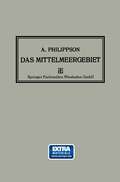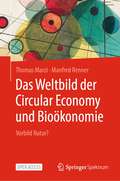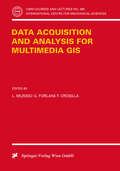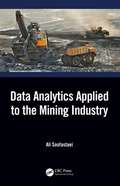- Table View
- List View
Das Mittelmeergebiet: Seine Geographische und Kulturelle Eigenart
by Alfred PhilippsonDieser Buchtitel ist Teil des Digitalisierungsprojekts Springer Book Archives mit Publikationen, die seit den Anfängen des Verlags von 1842 erschienen sind. Der Verlag stellt mit diesem Archiv Quellen für die historische wie auch die disziplingeschichtliche Forschung zur Verfügung, die jeweils im historischen Kontext betrachtet werden müssen. Dieser Titel erschien in der Zeit vor 1945 und wird daher in seiner zeittypischen politisch-ideologischen Ausrichtung vom Verlag nicht beworben.
Das nordwestdeutsche Erdölvorkommen: Chemisch-physikalisch-geologisch
by Heinrich OffermannDieser Buchtitel ist Teil des Digitalisierungsprojekts Springer Book Archives mit Publikationen, die seit den Anfängen des Verlags von 1842 erschienen sind. Der Verlag stellt mit diesem Archiv Quellen für die historische wie auch die disziplingeschichtliche Forschung zur Verfügung, die jeweils im historischen Kontext betrachtet werden müssen. Dieser Titel erschien in der Zeit vor 1945 und wird daher in seiner zeittypischen politisch-ideologischen Ausrichtung vom Verlag nicht beworben.
Das Problem der ostalpinen Metallogenese, beleuchtet am Beispiel einiger Erzparagenesen vom Alpenostrand
by Werner TufarDas Quartär in den Tropen: Eine Rekonstruktion des Paläoklimas
by Klaus HeineDas Eiszeitalter (Quartär) ist eine Zeit extremer Klimaschwankungen, die zum Anwachsen und Abschmelzen gewaltiger Eisschilde in den hohen Breiten führten. Die tropischen Wüsten, Savannen, Regenwälder und Gebirgsregionen erlebten gleichermaßen dramatische Klimaänderungen, deren Spuren in sedimentären Ablagerungen erhalten geblieben sind. Die Kenntnis der tropischen Klimageschichte ist von größter Bedeutung, da in den Tropen und Randtropen natürliche und – neuerdings – vom Menschen ausgelöste Prozesse das weltweite Klima maßgeblich steuern. Dennoch sind aus diesen Regionen nur relativ wenige Paläoklimadaten bekannt. Dieses Buch stellt die Klimaarchive der Tropen vor und diskutiert kritisch deren paläoklimatischen Aussagewert. Mit seiner holistischen Sicht auf der Basis von jahrzehntelangen eigenen Forschungen zeigt der Autor auf, dass mangelnde geoökologische Kenntnisse der Tropenwelt zu Fehldeutungen in den Modellierungen der Klimazukunft führen können. Die hier präsentierten Ergebnisse fordern eine Korrektur vieler weit verbreiteter Ansichten über die Bedeutung der atmosphärischen Treibhausgase für die globale Erwärmung der letzten 150 Jahre.
Das römische Rheinland Archäologische Forschungen seit 1945 (Arbeitsgemeinschaft für Forschung des Landes Nordrhein-Westfalen #86)
by Harald von PetrikovitsSchon öfters wurde von Fachkollegen, allgemein Interessierten, Studen ten und Verlegern der Wunsch geäußert, daß ein Buch über Geschichte und Kultur der römischen Rheinzone geschrieben würde, da die Schrift "Die Römer in Deutschland" von F. Koeppbereits veraltet ist. Die Bücher von A. W. Byvanck, R. G. Collingwood, A. Grenier und F. Staehelin über die römische Epoche ihrer Länder zeigen, welch großen Nutzen der Forscher und alle, die Geschichte als Bildungsinhalt bewegt, aus solchen Studien zu gewinnen vermögen. Wir meinen aber, daß die archäologischen Untersuchun gen, die nach dem zweiten Weltkrieg an vielen Stellen Deutschlands be gonnen wurden, unser Bild von der römischen Epoche der Rheinzone so tiefgreifend verändern, daß man die gewünschte Gesamtdarstellung auf eine Zeit verschieben sollte, in der die Ergebnisse der laufenden Untersuchungen besser zu übersehen sind. Das wird noch einige Jahre voller Arbeit dauern. Um aber schon jetzt einen überblick zu geben, welche Fragestellungen uns bei del1 archäologischen Grabungen im Rheinland beschäftigen, hielten wir es für nützlich, einen Vortrag über archäologische Forschungen im Rheinland seit dem zweiten Weltkrieg zu diesem Bericht zu erweitern und mit aus reichend vielen Plänen, Abbildungen und Belegen auszustatten. Ich danke der Arbeitsgemeinschaft für Forschung des Landes Nordrhein-Westfalen und dem Westdeutschen Verlag für das Entgegenkommen, das sie mir bei der Herausgabe dieser Schrift erwiesen haben. An der Diskussion, die sich an meinen Vortrag anschloß, beteiligten sich die Herren: L. Brandt, Tb. Kraus, Prälat G. Schreiber, H. E. Stier, J. Trier und L. Weisgerber.
Das Schwert in Mythos und Handwerk / Über die Ergebnisse neuerer metallkundlicher Untersuchungen alter Eisenfunde und ihre Bedeutung für die Technik und die Archäologie (Arbeitsgemeinschaft für Forschung des Landes Nordrhein-Westfalen #91)
by Franz WeverDas System Bioökonomie
by Daniela Thrän Urs MoesenfechtelDieses Buch ist eine prägnante Gesamtschau auf den Status Quo der Bioökonomie und ihre zukünftigen Entwicklungen – in Deutschland und darüber hinaus. Zahlreiche Praktikerinnen und Praktiker aus Wirtschaft, Wissenschaft, Zivilgesellschaft und Politik zeigen, wie die Bioökonomie den globalen Problemen der Zukunft begegnet. Auf der Basis nachwachsender Rohstoffe und Energien entwickelt die Bioökonomie neue Produkte und Verfahrensweisen und möchte so eine ökologisch und ökonomisch nachhaltigere Zukunft gestalten. Doch kann ihr das gelingen? Wo liegen ihre Möglichkeiten und Grenzen? Welche Rahmenbedingungen beeinflussen sie? Das Buch beantwortet diese Fragen mit einer systemischen Sicht auf die Bioökonomie und ermöglicht so eine schnelle Orientierung in diesem Thema. Das wird durch zahlreiche Grafiken zusätzlich unterstützt. Somit lädt das Buch dazu ein, die Zukunft der Bioökonomie mitzugestalten.
Das Verwerferproblem im Lichte des Markscheiders
by NA HornochDieser Buchtitel ist Teil des Digitalisierungsprojekts Springer Book Archives mit Publikationen, die seit den Anfängen des Verlags von 1842 erschienen sind. Der Verlag stellt mit diesem Archiv Quellen für die historische wie auch die disziplingeschichtliche Forschung zur Verfügung, die jeweils im historischen Kontext betrachtet werden müssen. Dieser Titel erschien in der Zeit vor 1945 und wird daher in seiner zeittypischen politisch-ideologischen Ausrichtung vom Verlag nicht beworben.
Das Wasser: Seine Gewinnung, Verwendung und Beseitigung mit Besonderer Berücksichtigung der Flussverunreinigung (Chemische Technologie in Einzeldarstellungen)
by Ferdinand FischerDieser Buchtitel ist Teil des Digitalisierungsprojekts Springer Book Archives mit Publikationen, die seit den Anfängen des Verlags von 1842 erschienen sind. Der Verlag stellt mit diesem Archiv Quellen für die historische wie auch die disziplingeschichtliche Forschung zur Verfügung, die jeweils im historischen Kontext betrachtet werden müssen. Dieser Titel erschien in der Zeit vor 1945 und wird daher in seiner zeittypischen politisch-ideologischen Ausrichtung vom Verlag nicht beworben.
Das Weltbild der Circular Economy und Bioökonomie: Vorbild Natur?
by Thomas Marzi Manfred RennerDies ist ein Open-Access-Buch. Bei der Suche nach neuen Wirtschaftsformen richten sich viele Hoffnungen auf die Circular Economy und Bioökonomie. Beiden wird das Potenzial zugesprochen, die Natur mit ihren Ressourcen zu schützen und gleichzeitig wirtschaftliches Wachstum zu ermöglichen. Welche Vorstellungen aber wirken in ihrem Hintergrund? Bei beiden Konzepten spielen die „Kreisläufe der Natur“ eine wesentliche Rolle. In manchen Denkschulen der Circular Economy sind sie ein Vorbild, nach dem Wirtschaftsprozesse gestaltet werden sollen. In der Bioökonomie sind sie „die“ Grundlage des Wirtschaftens. Dieses „Weltbild der Circular Economy und Bioökonomie“ ist Thema des vorliegenden Buches.
Das Weltbudget: Sichere und faire Ressourcennutzung als globale Überlebensstrategie
by Stefan BringezuDieses Buch beschreibt die zukunftsfähige Gestaltung der physischen Basis von Wirtschaft und Gesellschaft insgesamt durch eine gerechte Steuerung des weltweiten Ressourcenverbrauchs.Es erläutert Strategien, die die Entwicklung von Gesellschaften und Individuen auch bei begrenztem Güterverbrauch ermöglichen und gleichzeitig dem universellen Bedürfnis des Menschen nach Sicherheit und Unabhängigkeit entgegenkommen. Die Idee eines Weltbudgets der globalen Ressourcennutzung kann als wichtige Referenz für das Management auf der internationalen, nationalen und lokalen Ebene dienen und den Verbrauch weltweit auf eine sichere und faire Basis stellen. So lassen sich wirksame Hebel gezielt dort ansetzen, wo der Verbrauch wesentlich bestimmt wird: bei Art und Umfang von Produktion und Konsum sowie der Gestaltung der Infrastrukturen.Als Zielorientierung und Referenz dienen konkrete Obergrenzen für die Nutzung globaler Ressourcen, um ein gutes Leben für alle auf diesem Planeten zu sichern.
Das Wettersatellitenbild - Beispiele seiner geographischen Aussagemöglichkeiten (Forschungsberichte des Landes Nordrhein-Westfalen #2556)
by Wilhelm LauerDas Zwillingsparadoxon (essentials)
by Helmut GüntherDie bewegte Uhr geht nach. – Zwei Zwillinge bewegen sich in entgegengesetzter Richtung. Beide beobachten, dass die Uhr des anderen nachgeht. Dann kommen sie wieder zusammen und stellen fest: Jünger ist, wer seine Geschwindigkeit geändert hat. Eine elementare Erklärung dafür folgt aus einer Kette von Ungleichungen auf der Basis der Zeitdilatation. Mit Hilfe der Definition einer absoluten Gleichzeitigkeit finden wir eine weitere, einfache Erklärung. Hierbei ist es wichtig, den definitorischen Charakter der Gleichzeitigkeit zu verstehen. Alternativ zu Einsteins Herleitung formulieren wir einen anschaulichen Zugang zur Speziellen Relativitätstheorie. Dabei können wir über die Gleichzeitigkeit frei verfügen und lösen das Paradoxon sowohl mit der Lorentz-Transformation als auch bei absoluter Gleichzeitigkeit.
Das Zwillingsparadoxon unter Berücksichtigung der Gravitation (essentials)
by Helmut GüntherDie bewegte Uhr und eine Uhr im Gravitationsfeld gehen nach. Das berühmte Paradoxon von den Zwillingen, die sich erst voneinander entfernen und dann wieder zusammenkommen, untersuchen wir zunächst im speziell-relativistischen Gedankenexperiment, also ohne Gravitation. Der Zwilling, der seinen Bruder mit einer höheren Geschwindigkeit wieder einholt, bleibt am Ende der jüngere, was sich mit der sog. Zwillingsungleichung einfach verifizieren lässt.Die Gravitation kann prinzipiell nicht abgeschirmt werden. Ihren Einfluss auf den Gang einer Uhr verstehen wir mit einem Gedankenexperiment von V. Müller. Während die Zwillinge betragsmäßig immer dieselbe Geschwindigkeit zueinander besitzen, gelangen sie aber bei ihrer Bewegung durch den Raum in die Nähe verschiedener Massen, so dass sie unterschiedlicher Gravitation ausgesetzt sind. Das kann dazu führen, dass am Ende der zurückkehrende Zwilling sogar der ältere ist.
Data Acquisition and Analysis for Multimedia GIS (CISM International Centre for Mechanical Sciences #365)
by L. Mussio G. Forlani F. CrosillaContaining 31 papers collected in five chapters, this book deals with different fields of application and the problems of modelling and organising data in structures, as well as the processing techniques of GIS data for queries to the system and the so-called Dynamic GIS. The authors cover data acquisition with low cost DGPS for road surveys, vehicle navigation systems, and robust statistical techniques applied to pre-processing, analysis and testing. They report on the testing and calibration of different scanners for GIS data acquisition as well as some original approaches to the automatic DTM generation for cartographic and close range applications. Finally, applications to the environmental monitoring and the use of different kinds of geodetic data in multipurpose regional GIS are shown.
Data Analysis: Statistical and Computational Methods for Scientists and Engineers
by Siegmund BrandtThe fourth edition of this successful textbook presents a comprehensive introduction to statistical and numerical methods for the evaluation of empirical and experimental data. Equal weight is given to statistical theory and practical problems. The concise mathematical treatment of the subject matter is illustrated by many examples and for the present edition a library of Java programs has been developed. It comprises methods of numerical data analysis and graphical representation as well as many example programs and solutions to programming problems.The book is conceived both as an introduction and as a work of reference. In particular it addresses itself to students, scientists and practitioners in science and engineering as a help in the analysis of their data in laboratory courses, in working for bachelor or master degrees, in thesis work, and in research and professional work.
Data Analysis: Statistical and Computational Methods for Scientists and Engineers
by Siegmund BrandtBridging the gap between statistical theory and physical experiment, this is a thorough introduction to the statistical methods used in the experimental physical sciences and to the numerical methods used to implement them. The treatment emphasises concise but rigorous mathematics but always retains its focus on applications. Readers are assumed to have a sound basic knowledge of differential and integral calculus and some knowledge of vectors and matrices. After an introduction to probability, random variables, computer generation of random numbers and important distributions, the book turns to statistical samples, the maximum likelihood method, and the testing of statistical hypotheses. The discussion concludes with several important statistical methods: least squares, analysis of variance, polynomial regression, and analysis of time series. Appendices provide the necessary methods of matrix algebra, combinatorics, and many sets of useful algorithms and formulae.
Data Analysis for Direct Numerical Simulations of Turbulent Combustion: From Equation-Based Analysis to Machine Learning
by Heinz Pitsch Antonio AttiliThis book presents methodologies for analysing large data sets produced by the direct numerical simulation (DNS) of turbulence and combustion. It describes the development of models that can be used to analyse large eddy simulations, and highlights both the most common techniques and newly emerging ones. The chapters, written by internationally respected experts, invite readers to consider DNS of turbulence and combustion from a formal, data-driven standpoint, rather than one led by experience and intuition. This perspective allows readers to recognise the shortcomings of existing models, with the ultimate goal of quantifying and reducing model-based uncertainty. In addition, recent advances in machine learning and statistical inferences offer new insights on the interpretation of DNS data. The book will especially benefit graduate-level students and researchers in mechanical and aerospace engineering, e.g. those with an interest in general fluid mechanics, applied mathematics, and the environmental and atmospheric sciences.
Data Analysis for Scientists and Engineers (PDF)
by Edward L. RobinsonData Analysis for Scientists and Engineers is a modern, graduate-level text on data analysis techniques for physical science and engineering students as well as working scientists and engineers. Edward Robinson emphasizes the principles behind various techniques so that practitioners can adapt them to their own problems, or develop new techniques when necessary. Robinson divides the book into three sections. The first section covers basic concepts in probability and includes a chapter on Monte Carlo methods with an extended discussion of Markov chain Monte Carlo sampling. The second section introduces statistics and then develops tools for fitting models to data, comparing and contrasting techniques from both frequentist and Bayesian perspectives. The final section is devoted to methods for analyzing sequences of data, such as correlation functions, periodograms, and image reconstruction. While it goes beyond elementary statistics, the text is self-contained and accessible to readers from a wide variety of backgrounds. Specialized mathematical topics are included in an appendix. Based on a graduate course on data analysis that the author has taught for many years, and couched in the looser, workaday language of scientists and engineers who wrestle directly with data, this book is ideal for courses on data analysis and a valuable resource for students, instructors, and practitioners in the physical sciences and engineering. In-depth discussion of data analysis for scientists and engineers Coverage of both frequentist and Bayesian approaches to data analysis Extensive look at analysis techniques for time-series data and images Detailed exploration of linear and nonlinear modeling of data Emphasis on error analysis Instructor's manual (available only to professors)
Data Analysis for the Geosciences: Essentials of Uncertainty, Comparison, and Visualization (AGU Advanced Textbooks)
by Michael W. LiemohnData Analysis for the Geosciences Essentials of Uncertainty, Comparison, and Visualization Data Analysis for the Geosciences: Essentials of Uncertainty, Comparison, and Visualization is a textbook for upper-level undergraduate STEM students, designed to be their statistics course in a degree program. This volume provides a comprehensive introduction to data analysis, visualization, and data-model comparisons and metrics, within the framework of the uncertainty around the values. It offers a learning experience based on real data from the Earth, ocean, atmospheric, space, and planetary sciences. About this volume: Serves as an initial course in scientific data analysis and hypothesis testing Focuses on the methods of data processing Introduces a wide range of analysis techniques Describes the many ways to compare data with models Centers on applications rather than derivations Explains how to select appropriate statistics for meaningful decisions Explores the importance of the concept of uncertainty Uses examples from real geoscience observations Homework problems at the end of chapters The American Geophysical Union promotes discovery in Earth and space science for the benefit of humanity. Its publications disseminate scientific knowledge and provide resources for researchers, students, and professionals.
Data Analysis for the Geosciences: Essentials of Uncertainty, Comparison, and Visualization (AGU Advanced Textbooks)
by Michael W. LiemohnAn initial course in scientific data analysis and hypothesis testing designed for students in all science, technology, engineering, and mathematics disciplines Data Analysis for the Geosciences: Essentials of Uncertainty, Comparison, and Visualization is a textbook for upper-level undergraduate STEM students, designed to be their statistics course in a degree program. This volume provides a comprehensive introduction to data analysis, visualization, and data-model comparisons and metrics, within the framework of the uncertainty around the values. It offers a learning experience based on real data from the Earth, ocean, atmospheric, space, and planetary sciences. About this volume: Serves as an initial course in scientific data analysis and hypothesis testing Focuses on the methods of data processing Introduces a wide range of analysis techniques Describes the many ways to compare data with models Centers on applications rather than derivations Explains how to select appropriate statistics for meaningful decisions Explores the importance of the concept of uncertainty Uses examples from real geoscience observations Homework problems at the end of chapters The American Geophysical Union promotes discovery in Earth and space science for the benefit of humanity. Its publications disseminate scientific knowledge and provide resources for researchers, students, and professionals.
Data Analysis in Cosmology (Lecture Notes in Physics #665)
by Vicent J. Martinez Enn Saar Enrique Martinez Gonzales Maria Jesus Pons-BorderiaThe amount of cosmological data has dramatically increased in the past decades due to an unprecedented development of telescopes, detectors and satellites. Efficiently handling and analysing new data of the order of terabytes per day requires not only computer power to be processed but also the development of sophisticated algorithms and pipelines.Aiming at students and researchers the lecture notes in this volume explain in pedagogical manner the best techniques used to extract information from cosmological data, as well as reliable methods that should help us improve our view of the universe.
Data Analytics Applied to the Mining Industry
by Ali SoofastaeiData Analytics Applied to the Mining Industry describes the key challenges facing the mining sector as it transforms into a digital industry able to fully exploit process automation, remote operation centers, autonomous equipment and the opportunities offered by the industrial internet of things. It provides guidelines on how data needs to be collected, stored and managed to enable the different advanced data analytics methods to be applied effectively in practice, through use of case studies, and worked examples. Aimed at graduate students, researchers, and professionals in the industry of mining engineering, this book: Explains how to implement advanced data analytics through case studies and examples in mining engineering Provides approaches and methods to improve data-driven decision making Explains a concise overview of the state of the art for Mining Executives and Managers Highlights and describes critical opportunity areas for mining optimization Brings experience and learning in digital transformation from adjacent sectors
Data Analytics Applied to the Mining Industry
by Ali SoofastaeiData Analytics Applied to the Mining Industry describes the key challenges facing the mining sector as it transforms into a digital industry able to fully exploit process automation, remote operation centers, autonomous equipment and the opportunities offered by the industrial internet of things. It provides guidelines on how data needs to be collected, stored and managed to enable the different advanced data analytics methods to be applied effectively in practice, through use of case studies, and worked examples. Aimed at graduate students, researchers, and professionals in the industry of mining engineering, this book: Explains how to implement advanced data analytics through case studies and examples in mining engineering Provides approaches and methods to improve data-driven decision making Explains a concise overview of the state of the art for Mining Executives and Managers Highlights and describes critical opportunity areas for mining optimization Brings experience and learning in digital transformation from adjacent sectors






















